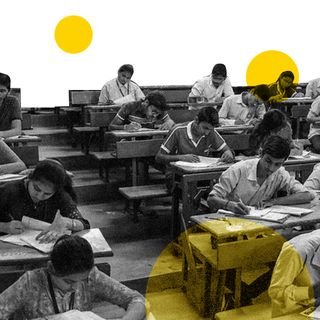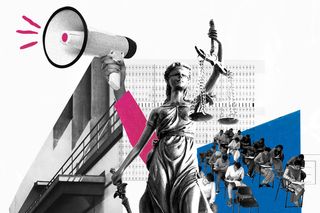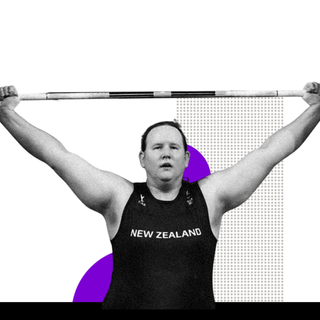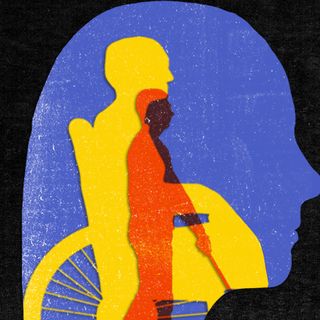
Making Indian Legal Education More Inclusive Is Key to Building a More Equitable Judicial System
Legal education in India marginalizes already marginalized groups, resulting in a lack of representation in the country’s legal system.

“It’s a real wonder that I even dared to dream of studying law one day, given the community I come from,” says Karthika Annamalai, who graduated from NUJS in 2017.
Karthika’s sentiments are not unfounded. A lack of diversity in the Indian judicial system — in terms of religion, caste, class, and gender — has long been evident. And this starts at the very beginning — the legal education system.
According to a report by Increasing Diversity by Increasing Access (IDIA), more than 85% of students who made it to the prestigious National Law Universities (NLUs) were Hindus and, of them, more than 30% belonged to the Brahmin community — the dominant Hindu caste. On the other hand, less than 4% of the students were Muslim, who constitute 14% of India’s population.
In the long run, this systemic lack of representation impacts the citizenry’s access to justice. When the new generation of lawyers — homogenous in caste and class backgrounds — become part of larger institutions in charge of delivering justice, their limited understanding of intersectionality can eclipse the “justice” being delivered.
“A more diverse judiciary also ensures that a diversity of perspectives is taken into account,” explained Justice DY Chandrachud in a speech. The most fundamental way of achieving this greater diversity is by ensuring the legal education system is more diverse.
However, systemic gatekeeping excludes marginalized communities from the legal profession — and it begins at the stage of admission to the country’s top law schools. The Common Law Admission Test, or CLAT — the national level entrance test for admission NLUs across India — is highly non-inclusive in nature. For instance, some questions in the test require spatial and visual interpretation, putting visually impaired candidates at an obvious disadvantage.
Moreover, not only is the test conducted only in English, but it also has a section that tests candidates’ proficiency in the language — creating an uneven playing field for students from disadvantaged socio-economic backgrounds and furthering English hegemony.
According to the IDIA report, more than 95% of the students admitted to the NLUs had been educated in English-medium schools and more than 50% of the students hailed from families where both parents were proficient in the language.
It should be noted that the Indian Constitution recognizes English as the primary language of proceedings in the Supreme Court as well as the High Courts, making the subject a rather important part of an individual’s legal career. However, this is not a reason to exclude individuals with non-English backgrounds from entering the legal field. This is perhaps why universities like NUJS, Kolkata, have begun offering the subject as a course during the very first semester of law schools. In fact, the government had proposed in 2019 that legal education be made bilingual — offered in the respective state’s regional language, besides English.
Related on The Swaddle:
The Vicious Cycle of Sexism in the Indian Court System
The gatekeeping that makes English a prerequisite to one’s legal career in India is also a marker of the glaring disparity in the economic backgrounds of students in NLUs. A 2014 survey revealed that nearly 80% of students took coaching for CLAT, costing above Rs. 1 lakh — an economic capital not accessible to many in India.
For students from marginalized communities who manage to overcome these odds and secure admission in NLUs, the struggles are far from over. Often, the cultural fabric of these institutions is embedded with socio-economic supremacy.
“Simply granting reservations doesn’t make law schools inclusive — there’s a lot of resentment our peers hold against students coming from marginalized communities, and that creates a very hostile environment. Our capabilities and caliber are constantly questioned,” says Itla Ragiri Jayalakshmi, a human rights lawyer, who graduated from NLS, Bangalore, and now runs Samam, a socio-legal organization fighting for the rights of the marginalized. Following the death of Rohith Vemula in 2016 due to caste-based atrocities, Jayalakshmi had started Savitri Phule Ambedkar Caravan, a student-led initiative to talk about caste discourse in NLS. She recalls her driving factor being the lack of caste-sensitive groups on her campus — like the ones that existed for queer communities.
The discrimination that students face due to their marginalized identities has very tangible repercussions. In 2019, a first-year student at NLU, Bhopal, committed suicide after being constantly “mocked” by his peers for his English language skills being “weak.”
This ridicule and lack of social acceptance — of people from a lower caste, a small town, or a vernacular schooling background — also impacts their academic performance. “The people who drop out of colleges, or get year losses, are often dealing with these factors in addition to academic pressure,” points out Jayalakshmi. “It’s not a mere coincidence if the trend repeats year after year.”
Jayalakshmi’s observations echo the findings of another study from 2019. Conducted by NUJS, the study found that in the seven-point grading system followed by the law school, more than 50% of students belonging to Scheduled Tribes and almost 35% belonging to Scheduled Castes had scored below 3; no ST-student had scored above 5 and only one SC student had scored above 6.
Related on The Swaddle:
Almost 84% of Cases Filed by SC/ST Women, Children Are Pending in Court: Govt Panel
The elitism prevalent in the field translates directly into the careers of students from marginalized communities. As Jayalakshmi explains, they often don’t have the financial and social capital to intern under the top lawyers or at the country’s biggest law firms — lacking both connections to secure such internships or funds to afford accommodations in metropolitan cities, where most of these offices are.
“Even employment at the chambers of advocates/senior advocates are based on informal references through privileged networks and those students who hail from families having roots in the legal profession have an edge over the others,” said Justice Chandrachud.
Moreover, lack of diversity in the student body also translates into the under-representation of marginalized communities in college faculty boards. This, too, has significant repercussions for the legal justice system — since faculty members are in charge of shaping future legal minds, their opinions and worldviews can influence those of young lawyers. “When people come from a society riddled with different discriminations, the university should stand as a bulwark against that — serving as a transformative experience — much more so, for law,” says Kunal Ambasta, an openly queer assistant professor at NLS.
Arguably, the privileged background of faculty members prevents them from understanding or encouraging the nuances of intersectionality in the classroom. “It is probably owing to the fact that the poorest of the poor rarely make it to any law school, that professors conduct discussions on socio-economic matters and fundamental rights such as right to education, right to food, right to shelter, caste-related violence in a rather insensitive manner,” says Annamalai. She recalls how it was extremely uncomfortable for her, hailing from a “community that has been deprived of most of the aforesaid fundamental rights for decades,” to hear her peers argue during classroom debates that “there’s [no] point of even discussing the right to education for the poor when all they care about is where their next meal is coming from.”
A Muslim student from one of the top NLUs also spoke about how, although the faculty members didn’t intend malice, their biases were nevertheless reflected in the classroom. “Some of [them], owing to their own relative inexperience, made certain assumptions about Muslims which could be construed as being tone-deaf or heavy-handed.”
This insensitivity and prejudice — left unaddressed in the classroom — make their way into the country’s justice system. “It really doesn’t surprise me to see judges today write the most insensitive and bizarre judgments around fundamental rights, when I was constantly surrounded by law students with no real awareness of the ground reality or empathy for the impoverished,” Annamalai noted.
These judgments are a testament to the lack of diversity that is mirrored in the upper echelons of the legal system. A 2021 report by Bar and Bench found that more than 50% of the Supreme Court justices have been upper-caste Hindus. Only one Dalit judge has served as the country’s Chief Justice. In the meantime, only about 7% of all justices and chief justices ever appointed to the apex court have been Muslim — of whom, only four made it to the position of the Chief Justice.
“Law schools serve as the gateway to the legal profession, and a lack of diversity and representation at law schools could only mean that the legal profession would also end up with an elitist and exclusive workforce,” the IDIA report noted.
Devrupa Rakshit is an Associate Editor at The Swaddle. She is a lawyer by education, a poet by accident, a painter by shaukh, and autistic by birth. You can find her on Instagram @devruparakshit.
Related


New Zealand Picks First Trans Athlete for Olympics, Sparking Debate About Inclusivity
